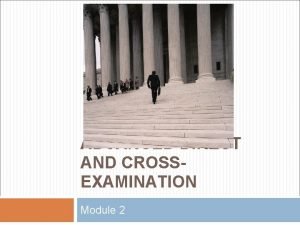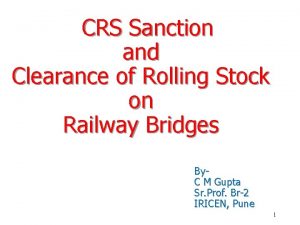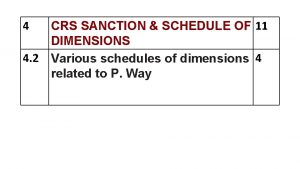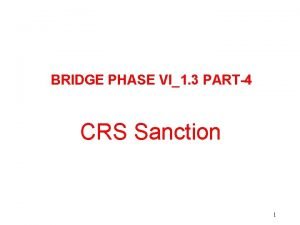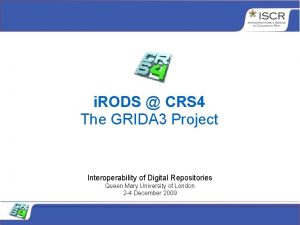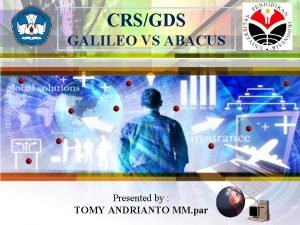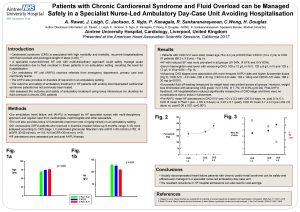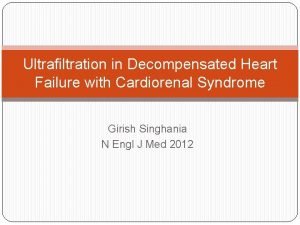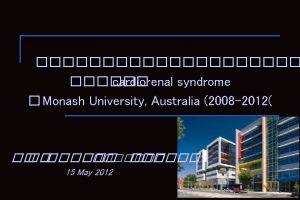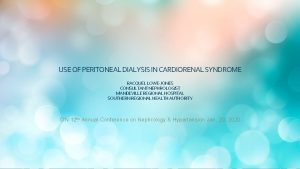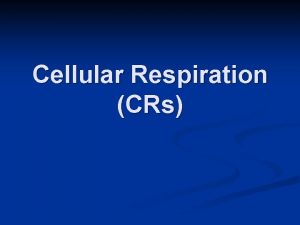Cardiorenal syndrome CRS R 4 Definition Patients with












- Slides: 12

Cardiorenal syndrome (CRS) 신장내과 R 4 강혜란

Definition § Patients with heart failure (HF) who have a reduced GFR -> Mortality ↑ § Patients with chronic kidney disease have an increased risk of both atherosclerotic cardiovascular disease and HF, and cardiovascular disease is responsible for up to 50 percent of deaths in patients with renal failure § Acute or chronic systemic disorders can cause both cardiac and renal dysfunction § “Cardiorenal syndrome” (CRS) has been applied to these interactions, but the definition and classification have not been clear

Classification § Type 1 (acute) § Acute HF results in acute kidney injury § Type 2 § Chronic cardiac dysfunction (chronic HF) causes progressive CKD § Type 3 § Abrupt and primary worsening of kidney function due, for example, to renal ischemia or glomerulonephritis causes acute cardiac dysfunction, which may be manifested by HF § Type 4 § Primary CKD contributes to cardiac dysfunction, which may be manifested by coronary disease, HF, or arrhythmia § Type 5 (secondary) § Acute or chronic systemic disorders (sepsis or diabetes mellitus) that cause both cardiac and renal dysfunction

Prevalence § The prevalence of moderate to severe kidney impairment (GFR < 60 m. L/min per 1. 73 m 2) in patients with HF § approximately 30 - 60 %

Diagnosis § § Impaired kidney function in patients with heart failure (HF) § Defined as a reduction in glomerular filtration rate (GFR) § The most common test used to estimate GFR : serum creatinine concentration Among patients with HF who have an elevated serum creatinine and/or a reduced estimated GFR § underlying kidney disease § impaired kidney function due to the cardiorenal syndrome (CRS) -> distinction may be difficult and some patients have both underlying chronic kidney disease and CRS

Diagnosis § Underlying kidney disease § significant proteinuria (> 1000 mg/day) § an active urine sediment with hematuria with or without pyuria § cellular casts § small kidneys

Diagnosis § BUN/Cr ratio § HF : cause of prerenal azotemia (↑) § not solely related to reduced cardiac output, frequently occurs in the setting of volume overload § Urine sodium concentration § < 25 meq/L : expected with HF § renal perfusion ↓ -> activation of the renin-angiotensin-aldosterone and sympathetic nervous systems -> promote sodium retention § ↑ : concurrent diuretic therapy

Pathophysiology § Neurohumoral adaptations § Reduced renal perfusion § Increased renal venous pressure § Right ventricular dysfunction

Reduced GFR and Prognosis § Reduced baseline GFR § Common in patients with heart failure (HF), Associated with increased mortality § A systematic review § mortality increased by approximately 15 % for every 10 m. L/min reduction in estimated GFR § Change in GFR during therapy for HF § A fall in GFR during treatment of HF : associated with increased mortality § However, other evidence suggests that patient outcomes may be improved with aggressive fluid removal even if accompanied by a rise in serum creatinine § Blood urea nitrogen § BUN or blood urea ↑: associated with increased mortality in patients with HF

Management § There are no medical therapies that have been shown to directly increase GFR in patients with the CRS § Improvement in cardiac function § § Associated with improved renal function in patients with types 1 and 2 CRS Diuretics § Loop diuretic, first-line therapy for managing volume overload in patients with HF as manifested by peripheral and/or pulmonary edema § The effect of diuretic-induced fluid removal : variable in patients with HF

Management § Renin-angiotensin-aldosterone-system antagonism § ACE inhibitor or ARB : standard part of therapy of HF with systolic dysfunction (symptomatic improvement, reduced hospitalization for HF, enhanced survival) -> not generally associated with an improvement in renal function § Patients with CKD, the risk of adverse events ↑ § hyperkalemia, worsening renal function § should be monitored closely during periods of drug initiation and titration § Vasodilators § acute decompensated HF include nitrates (nitroglycerin, nitroprusside), nesiritide -> worsening renal function § Inotropic drugs § uncertain and the routine use of inotropes cannot be recommended

Management § Ultrafiltration § Removal of isotonic fluid from the venous compartment via filtration of plasma across a semipermeable membrane § for patients with refractory congestion not responding to medical therapy



